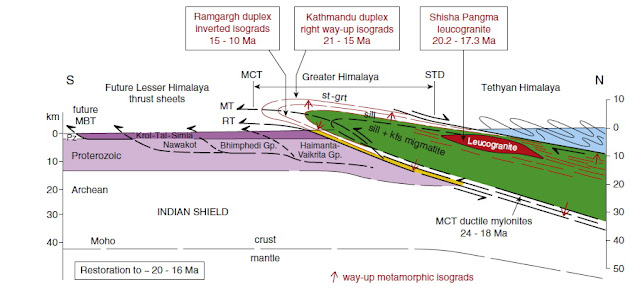As I settled down for lunch by the Sunderdunga riverside during my recent Kumaon trek, I noticed a polished boulder nearby. It had a striking appearance dominated by a large crystal of feldspar set in a much finer grained material. This finer matrix had a pronounced streaky fabric, as if made up of very fine layers. Upon closer examination, these layers or foliation was due to the planar arrangement of minerals like amphiboles, mica, quartz, and feldspar. The larger eye catching feldspar grain in the center of the boulder seems a little flattened along one axis and elongated along the orthogonal, giving it a crude sigmoid shape.
I had chanced upon a rock caught up in a shear zone. These are fault zones where movement of the crust causes intense rock deformation. The type of deformation I observed typically occurs at a deeper level where high temperatures make rocks soft and ductile. Rocks caught up in fault zones at shallower levels undergo brittle deformation. They have a broken appearance, made up of sharp edged fragments set in a crushed finer matrix. The rock is fractured, and these cracks get filled with minerals like calcite and quartz.
This typical brittle like deformation was absent in this rock. There was no sign of any fracturing and breakage of the rock. Instead, the finer grained minerals seemed to flow around the larger feldspar crystal. Grain size reduction occurs by plastic rearrangement of atomic layers and recrystallization of softer minerals during deformation. The stronger resistant minerals which remain as large crystals are called porphyroclasts. Since rocks are sliding past, there is a rotational component to deformation also. Larger grains often show signs of being rotated, while finer groundmass wraps around.
The end stage of such ductile deformation are rocks known as mylonites. These have a flinty or glassy appearance due to the extreme grain size reduction.
I suspect this particular rock has not quite reached the mylonite stage. Let us call it a protomylonite. It does show a clear contrast between the finer matrix made up of stretched and elongated minerals and a large porphyroclast.
The asymmetry of the porphyroclast gives geologists an idea of the sense of motion along faults. The annotated photo below shows the relative sense of shear or motion.
Hundreds of such measurements have been made in the Greater Himalaya. When measured in-situ, the direction of relative motion is 'top to the south', indicating the general direction of movement of Himalaya thrust faults. Deformation is not uniformly distributed throughout the Greater Himalaya but appears restricted to narrow zones. These zones of intense shearing containing deformed rocks including mylonites have allowed the recognition of major thrust fault zones such as the Main Central Thrust which emplaces the Greater Himalaya slab on top of the Lesser Himalaya.
There are minor shear zones too. I think this rock was eroded from one such shear zone in the Sunderdunga valley.
Coming back to the brittle versus ductile deformation regimes. Almost all the deformation you observe in the Greater Himalaya took place in the ductile regime. Here are a few examples from the Greater Himalaya of ductile deformation seen in schists and gneisess. These are my observations from various treks in the Kumaon.
A cross section of the Himalaya is presented here to showcase the metamorphic gradients along the Greater Himalaya slab (green). For this reading, you can ignore the rest of the Himalaya orogen shown in the figure. Temperature gradient increases towards the core of the slab with kyanite (k) and sillimanite (sill) as the prime high grade metamorphism indicators. This example is from the Nepal Himalaya, but the arrangement of the different Himalaya divisions is identical in adjacent Kumaon.
Source: Mike Searle et.al. Tectonophysics 2017
Notice the localization of mylonites along the Main Central Thrust zone. Metamorphism of rocks above around 600 degree centigrade during the Eocene (~35 million years ago) and in the Miocene (~25-16 million years ago) has resulted in the ubiquity of ductile deformation observed in the Greater Himalaya. In hotter pockets in the core, metamorphic rocks partially melted and the resulting granitic magma was injected along penetrative weak planes, forming dikes, sills, and small plutons.
Channeled between two great fault zones, the Main Central Thrust at the base and the South Tibetan Detachment as roof, this hot mushy crustal material was then tectonically extruded to shallower levels, its ductile fabrics frozen and preserved as the rocks cooled. Subsequent tectonism has superimposed brittle deformation on the Greater Himalaya ductile structures.
Finally, another beautiful example of a gneiss showing ductile shearing. Fish shaped white feldspar are set in a biotite mica and quartz matrix which flows around the porphyroclasts. Can you guess the sense of relative motion?
Observing features that you have seen only in a textbook - that is the great joy of going out in the field.






https://blogger.googleusercontent.com/img/b/R29vZ2xl/AVvXsEi_AIQlfcN4e6HKR1WiXunoBUjPOCDbKuQZRRyhAay5jVgsqrjFaeZbP1TP6n5uNCbSAx6TDw_autEQ1iYAub0J4OI9tbDwkrwg7Z0IJ6JkEztSQdIoxGmUJ1dmryxzniL_jhqosvn-AfXs6uqwPMebTwSaHjWq7-cxSbD67FWE1CS6u-glIgL9ksk76x8/s1842/mineral%20fish%203.jpg
ReplyDeleteI find the movement/sense of shear is sinistral rather than dextral! Its great!
Thanks for your interest.
ReplyDelete